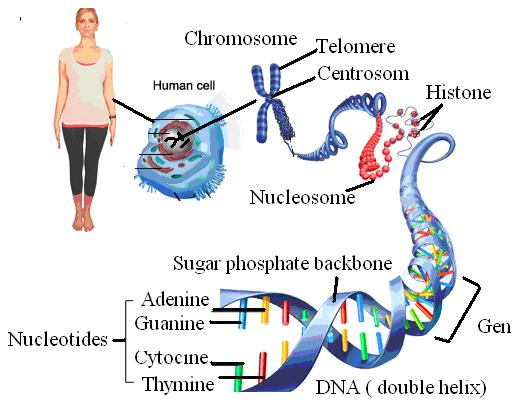
DNA, abbreviation of deoxyribonucleic
acid, organic chemical of complex molecular structure that is found in all
prokaryotic and eukaryotic cells and in many viruses. DNA codes genetic
information for the transmission of inherited traits.
The chemical DNA was first discovered
in 1869, but its role in genetic inheritance was not demonstrated until 1943.
In 1953 James Watson and Francis Crick determined that the structure of DNA is
a double-helix polymer, a spiral consisting of two DNA strands wound around
each other. Each strand is composed of a long chain of monomer nucleotides. The
nucleotide of DNA consists of a deoxyribose sugar molecule to which is attached
a phosphate group and one of four nitrogenous bases: two purines (adenine and
guanine) and two pyrimidines (cytosine and thymine). The nucleotides are joined
together by covalent bonds between the phosphate of one nucleotide and the
sugar of the next, forming a phosphate-sugar backbone from which the nitrogenous
bases protrude. One strand is held to another by hydrogen bonds between the
bases; the sequencing of this bonding is specific—i.e., adenine bonds only with
thymine, and cytosine only with guanine.
 |
| Human cells have 23 pairs of chromosomes. Each chromosome is made up of a DNA molecule that is made up of a series of nucleotides arranged in 2 strands that spiral to form a double helix. |
The configuration of the DNA molecule
is highly stable, allowing it to act as a template for the replication of new
DNA molecules, as well as for the production (transcription) of the related RNA
(ribonucleic acid) molecule. A segment of DNA that codes for the cell’s
synthesis of a specific protein is called a gene.
DNA replicates by separating into two
single strands, each of which serves as a template for a new strand. The new
strands are copied by the same principle of hydrogen-bond pairing between bases
that exists in the double helix. Two new double-stranded molecules of DNA are
produced, each containing one of the original strands and one new strand. This
“semiconservative” replication is the key to the stable inheritance of genetic
traits.
Within a cell, DNA is organized into
dense protein-DNA complexes called chromosomes. In eukaryotes, the chromosomes
are located in the nucleus, although DNA also is found in mitochondria and
chloroplasts. In prokaryotes, which do not have a membrane-bound nucleus, the
DNA is found as a single circular chromosome in the cytoplasm. Some
prokaryotes, such as bacteria, and a few eukaryotes have extrachromosomal DNA
known as plasmids, which are autonomous, self-replicating genetic material.
Plasmids have been used extensively in recombinant DNA technology to study gene
expression.
 |
| The initial proposal of the structure of DNA by James Watson and Francis Crick, which was accompanied by a suggestion on the means of replication. |
The genetic material of viruses may
be single- or double-stranded DNA or RNA. Retroviruses carry their genetic
material as single-stranded RNA and produce the enzyme reverse transcriptase,
which can generate DNA from the RNA strand. Four-stranded DNA complexes known
as G-quadruplexes have been observed in guanine-rich areas of the human genome.
Comments
Post a Comment